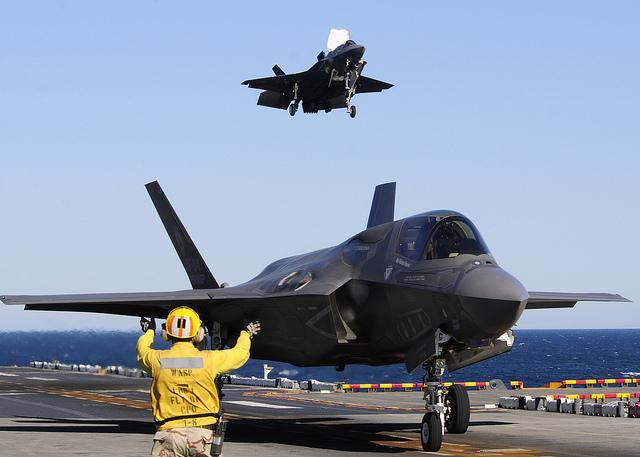
Nic Stuart’s piece, ‘Forget the carrier option’, makes a large and important judgment: that politics and defence funding won’t allow the option of deploying F-35Bs on Australia’s LHDs. But in making that case Nic repeats erroneous assumptions that are hindering a true exchange of views. It’s vital that defence reviews are supported with facts—and some of them bear repetition.
First up, the technical facts. F-35B operations from LHDs are feasible. The F-35B is specifically designed not to drive major ship modifications. The LHD wouldn’t need ‘conversion’ to take F-35Bs, although it would require minor modifications, similar to those being applied to the USN ‘Wasp’ class. The flight deck is capable of taking an F-35B. The F-35B won’t require massive changes to the ships’ air-traffic control facilities, assuming that they are already up to operating rotary-wing aircraft day or night in bad weather. It won’t need huge changes to ship structure or facilities.
Those modifications would’nt ‘cost a great deal’, as Nic stated. And to repeat, giving the LHD an ability to operate F-35B doesn’t mean turning it into a ‘mini aircraft carrier’.
Next, remarkable assumptions are being made about what embarked F-35Bs would do. Nic’s piece says that their role would be to provide ‘intimate air-cover’—a new and intriguing term. With a range of over 300 nautical miles, the most ‘intimate’ aspect of an F-35B air defence would probably be the effect of an AIM-120 warhead on an incoming threat. But that misses the key point: putting F-35Bs on an LHD would allow more effective use of all the aircraft’s capabilities, including precision-strike and ISTAR support, by putting the aircraft closer to the fight. As another article puts it, ‘proximity equals capability’. But be in no doubt, air cover will be a requirement for a task group operating anywhere near an enemy air threat. It won’t, as the article somewhat dismissively puts it, be a ‘nice to have’.
Nic assumes that the RAN would have to buy a third LHD (or a different ship optimised for F-35B) to make the exercise ‘worthwhile’. With this leap of logic, he argues that an F-35B option is unaffordable. But this is not a given. The two LHDs are highly capable and flexible assets—their Air Groups will be adjusted to meet the demands of future situations. Yes, embarking F-35Bs will displace some of the planned Air Group. But Tailored Air Groups (TAGs) are a common-place and well-understood way of using small decks to best effect. And be in no doubt, the ADF will have to adjust the LHD Air Groups in the future.
It’s almost certain that whatever operational assumptions the LHDs were bought against will change, and change fast. And the way the LHDs will be equipped and operated will need to change. Will amphibious operations be ADF only? Would both LHDs be available? Would they be part of an international task group with USMC participation? Would they be required to go where there might be an enemy air threat? We don’t know. But the ADF has to make the best use of the two ships they’ve got. Sticking to the line that ‘we can’t do it because that would mean changing our defence planning assumptions’ is guaranteed to make it worse.
Nic’s article also baldly states that F-35Bs on an LHD would be ‘pathetically inefficient’. That’s a bold claim, and should be examined against the actual experience of the RN and the USMC’s STOVL units over the last 30 years or so. (Actually, it’s eerily familiar to the arguments against the Sea Harrier/’Invincible’ class combination in the late 1970s. Those went away after what happened in the South Atlantic in 1982.) But it’s quite true that the issue of ‘efficiency’ should be considered, particularly for long-range air operations.
Nic asserts that ‘our pilots can cope’ with long flight times. Yes, of course they can, but that’s not the issue. Burning ‘more than 10 hours’ of flight time to deliver around 25 minutes of ‘air power’ might not be especially ‘efficient’. Critics of the F-35B/LHD option should do the maths on how many land-based aircraft (and tanker slots) are needed to provide continuous, reactive, air support at long range. Do some fuel-usage calculations. Now put 5 or 6 F-35Bs with the task group, on three-minute alert posture, 50 miles from the target and do the maths again. Now decide which option is ‘inefficient’. It’s a simple effect of geography. Proponents of the F-35B/LHD option aren’t saying it’s a replacement for land-based air power. It’s for when land-based aircraft, for reasons of pure physics, can’t do the job.
Finally, the article says: ‘There was…a good argument to be made for incorporating the STOVL version as a part of our original purchase of aircraft’. Agreed. It then says that ‘That chance has gone’. Not agreed. There’s nothing stopping the ADF making a final buy of 28 aircraft the F-35B variant. Or even switching some of the existing planned buy from the A variant to Bs. It’s a matter of political will.
The divergent views around this debate show just how important it is that the F-35B issue is thoroughly (and independently) investigated so that decisions are supported by facts. The UK’s failure to ‘get the facts right’ in their 2010 SDSR led to an F-35/carrier related mess of epic proportions. Australia now has the chance to do the job properly.
Steve George was an air engineer officer in the Royal Navy for 28 years, and served in HMS Invincible during the 1982 Falklands operation. During his career, he was closely involved with the Sea Harrier, and also with joint RN/RAF Harrier operations. Retiring from the RN as a Commander, he joined the JSF programme to work on F-35B ship suitability. He is now an engineering consultant. Image courtesy of Flickr user Official US Navy Page.